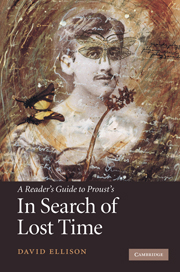Book contents
- Frontmatter
- Contents
- List of illustrations
- Preface
- Acknowledgements
- Chronology
- Introduction: At the threshold of Proust's novel
- 1 Du Côté de chez Swann [The Way by Swann's]
- 2 A l'Ombre des jeunes filles en fleurs [In the Shadow of Young Girls in Flower]
- 3 Le Côté de Guermantes [The Guermantes Way]
- 4 Sodome et Gomorrhe [Sodom and Gomorrah]
- 5 La Prisonnière [The Prisoner] and Albertine disparue [The Fugitive]
- 6 Le Temps retrouvé [Finding Time Again]
- Notes
- Select bibliography
- Index
6 - Le Temps retrouvé [Finding Time Again]
Published online by Cambridge University Press: 05 August 2012
- Frontmatter
- Contents
- List of illustrations
- Preface
- Acknowledgements
- Chronology
- Introduction: At the threshold of Proust's novel
- 1 Du Côté de chez Swann [The Way by Swann's]
- 2 A l'Ombre des jeunes filles en fleurs [In the Shadow of Young Girls in Flower]
- 3 Le Côté de Guermantes [The Guermantes Way]
- 4 Sodome et Gomorrhe [Sodom and Gomorrah]
- 5 La Prisonnière [The Prisoner] and Albertine disparue [The Fugitive]
- 6 Le Temps retrouvé [Finding Time Again]
- Notes
- Select bibliography
- Index
Summary
First published in 1927, five years after Proust's death, Le Temps retrouvé is the capstone of the 3,000-page literary quest to which the writer devoted and eventually sacrificed his life. Having taken great pains, throughout the compositional process, to ensure the architectural unity of his text, in the final volume of the novel Proust not only continues to develop and enrich the thematic material that had predominated in the earlier sections, but he also provides a retrospective, theoretically elaborated aesthetic justification for his work. Despite the considerable editorial problems presented by a text that had to be assembled posthumously from a number of manuscript and typescript sources, the general outline of the volume can be discerned quite clearly.
The first, concisely elaborated episode takes place in Tansonville, and is simply the continuation of the concluding pages of Albertine disparue (R IV, 275–301; S 6, 3–29). In this tranquil environment, the narrator takes walks with Gilberte, his first love now (unhappily) married to Robert de Saint-Loup, and reminisces about the past while also gaining further insight into Robert's homosexual leanings and relationships. These opening pages constitute a repetition of the threshold situation with which Proust had begun the novel, in the Overture of Du Côté de chez Swann. The narrator is middle-aged and is poised between the past experiences of his life, which have brought him knowledge of society and human nature without providing him with personal happiness, and the prospect of a future which seems bleak rather than promising.
- Type
- Chapter
- Information
- A Reader's Guide to Proust's 'In Search of Lost Time' , pp. 162 - 185Publisher: Cambridge University PressPrint publication year: 2010



